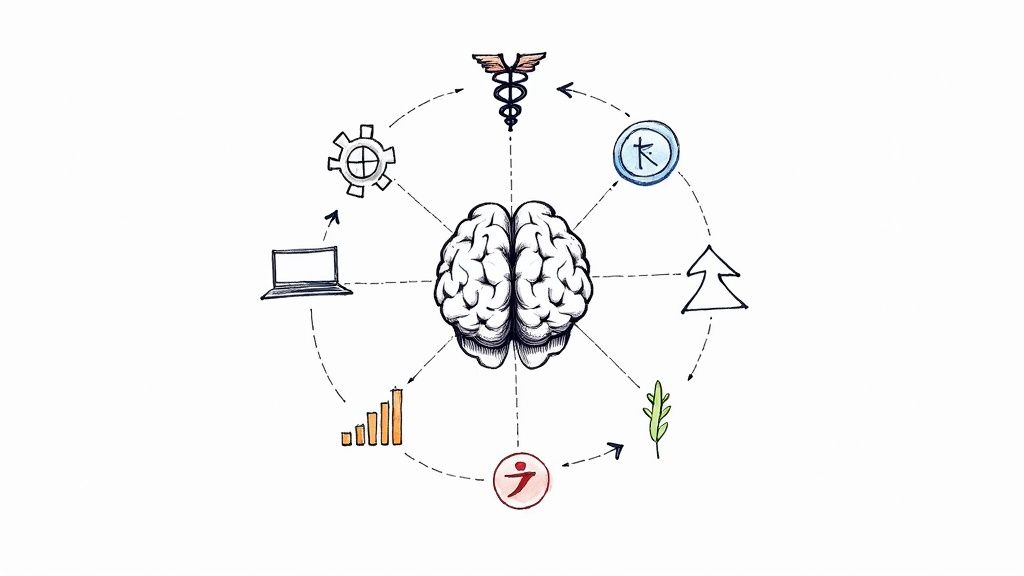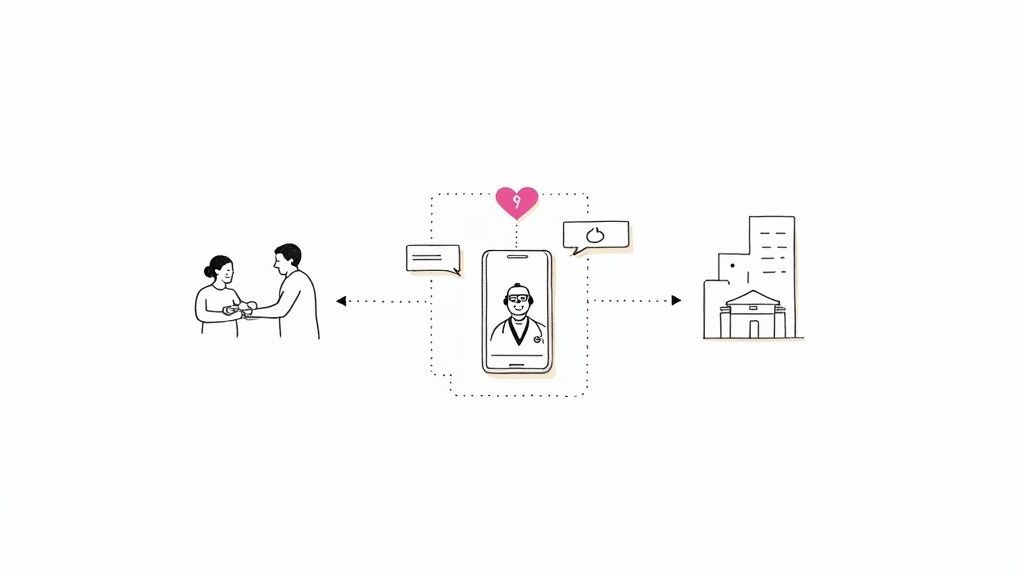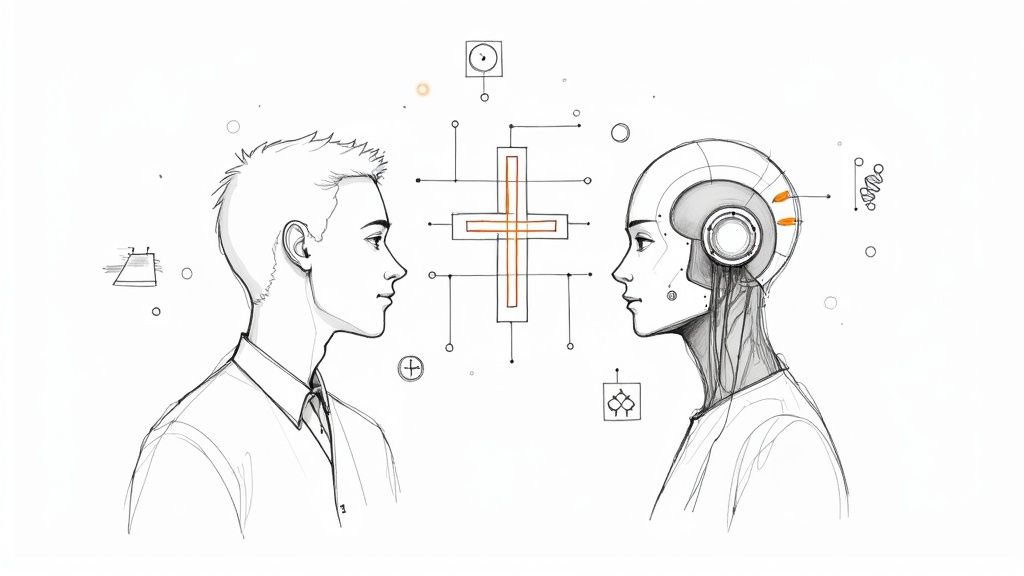Generative AI Healthcare Unlocks Medical Innovation
Discover how generative AI healthcare is revolutionizing patient outcomes and clinical workflows. Explore top use cases and strategic insights.
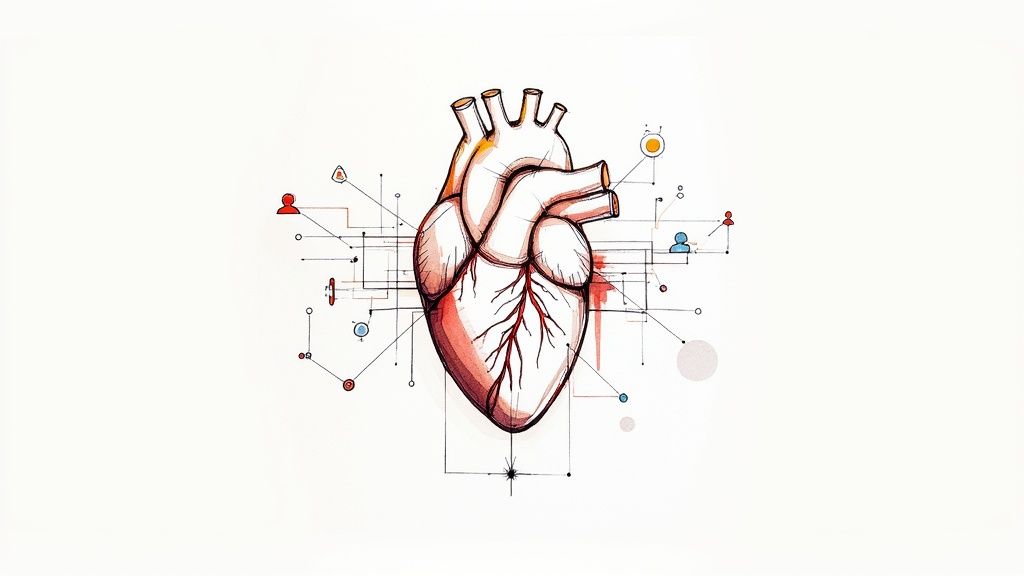
Picture this: a brilliant medical partner that can instantly pull together a patient's entire medical history, float potential diagnoses for a doctor to consider, and even help researchers design brand-new drugs. That's not science fiction anymore; it's the promise of generative AI in healthcare. This is a huge leap from AI that just analyzes data to AI that actively creates new, incredibly valuable information.
Redefining Healthcare with Generative AI
Traditional AI is great at finding patterns in data that already exists. Generative AI, on the other hand, produces something entirely new—things like clinical notes, personalized treatment plans, or even molecular structures for drug discovery. This couldn't come at a better time. The healthcare industry is wrestling with some persistent problems: clinician burnout, clunky operations, and the constant pressure to deliver better care for less money. These advanced AI Solutions are stepping in to tackle these challenges across the board, from the front desk to the research lab.
Why Now Is the Time for AI
The need for smarter tools in medicine has become urgent. Doctors and nurses report spending nearly 28 hours a week bogged down in administrative tasks, time that's stolen directly from patient care. It’s no wonder that a staggering 82% of clinicians report feeling the effects of burnout. Generative AI offers a real solution by automating tedious work and making sense of complex data.
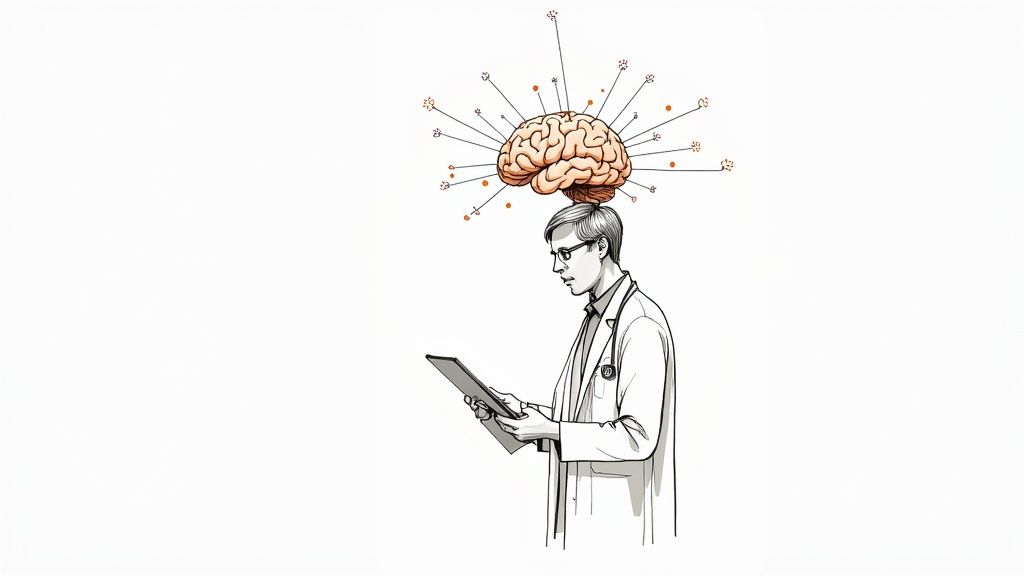
The adoption of this technology is already moving faster than we've seen with other medical breakthroughs. By early 2024, the use of generative AI in U.S. health systems exploded, particularly for clinical documentation. Tools like Ambient Notes, which automatically draft clinical summaries from patient conversations, saw nearly universal adoption among the health systems surveyed. Better yet, over 50% of these organizations called their implementation a major success. To put that in perspective, that's a much faster and more successful rollout than we saw with now-standard technologies like CT and MRI scans in their early days. You can discover more about these adoption trends in the full 2024 report.
The Core Promise for Medical Professionals
At its heart, generative AI isn't about replacing doctors—it's about giving them a powerful assistant to augment their skills. Its value really shines in a few key areas:
- Automating Documentation: Imagine an AI listening to a doctor-patient conversation and instantly generating a perfect clinical summary. This frees up hours of paperwork.
- Accelerating Diagnostics: It can analyze medical images and patient data, flagging potential areas of concern that a radiologist or pathologist can then investigate further.
- Personalizing Treatment: The technology can synthesize a patient's genetic profile, lifestyle factors, and medical history to suggest highly personalized treatment options.
This fundamental shift allows clinicians to take back their time, reduce the crushing weight of administrative burnout, and focus their incredible expertise where it matters most: with their patients. As we’ll see, the thoughtful implementation of generative AI in the healthcare industry isn't just a minor upgrade; it’s building a new foundation for a more efficient and humane system of care.
A Look Under the Hood: The Core AI Technologies
To really get what generative AI is doing in healthcare, you have to pop the hood and look at the engines driving all this change. These aren't just abstract ideas—they're real tools being fine-tuned every day to solve actual clinical problems. Let's demystify the tech to see how it goes from complex algorithms to applications that can save lives.
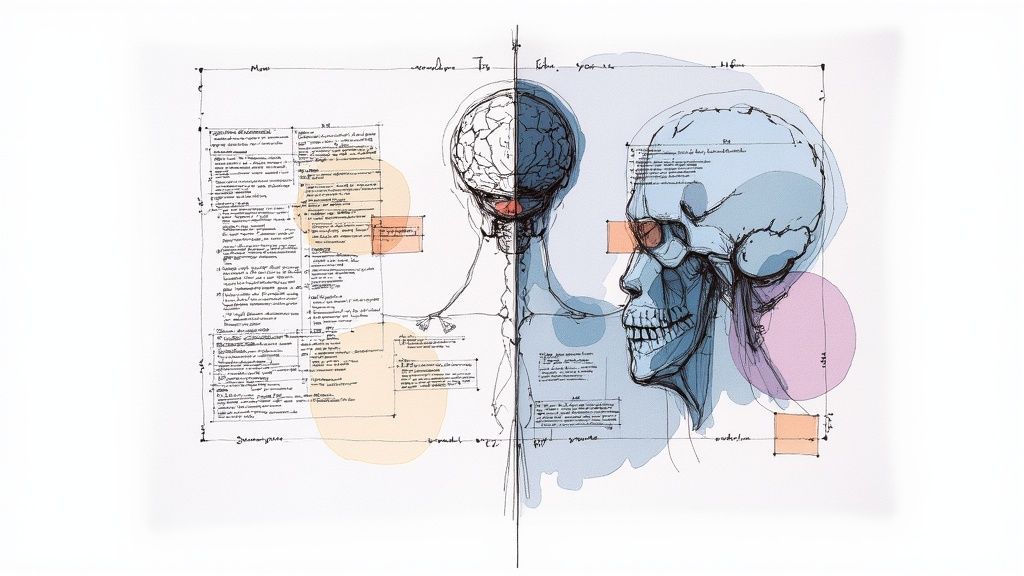
At the heart of it all, you'll almost always find Large Language Models (LLMs). The best way to think of an LLM is like a brilliant medical student who has read, absorbed, and can recall every single textbook, journal article, and clinical trial ever published. It can understand medical language, summarize complex cases, and generate text that sounds completely human.
For example, an LLM can listen to a doctor’s spoken notes after a patient visit and instantly draft a perfectly structured clinical summary. This is a huge part of our AI Product Development Workflow, where we turn these powerful models into practical tools that doctors and nurses can actually use.
The Power of Large Language Models
LLMs get their power from being trained on absolutely massive amounts of text and code. This allows them to spot patterns, understand context, and pick up on the subtle nuances of language. When you apply that to healthcare, it means they can take over a ton of tasks that used to eat up hours of a clinician's day.
- Clinical Documentation: Instead of typing out long notes, a doctor can review and approve a draft summary or referral letter generated by an LLM in seconds.
- Data Synthesis: An LLM can scan a patient’s entire electronic health record (EHR) and pull together a quick, coherent summary of their history, flagging the most important events.
- Patient Communication: These models can also draft clear, helpful answers to common patient questions, which frees up nurses to focus on more pressing clinical work.
Think of LLMs as a powerful cognitive assistant. They absorb and organize the overwhelming amount of information in modern medicine, letting clinicians get back to what they do best: critical thinking and patient care.
Figuring out where this kind of automation can make the biggest difference is a key part of effective AI strategy consulting, helping healthcare organizations pinpoint the best opportunities for impact.
Seeing the Whole Picture with Multimodal AI
But healthcare isn't just about words and text. You have images, lab results, and all sorts of other data. That’s where multimodal AI steps in. If an LLM is the book-smart medical student, think of multimodal AI as the seasoned specialist who sees connections across different types of information.
A multimodal system doesn't just read the radiologist's written report; it looks at the X-ray or CT scan at the same time. It learns to spot subtle links between the words in the report and the pixels in the image—patterns a human eye might easily miss.
This ability to process and connect different data streams—text, images, lab values, even genomic sequences—is a massive step forward. It gives us a far more complete picture of a patient's health and is a foundational element of the advanced AI Solutions we see today.
How Generative AI Is Actually Changing Patient Care
You can feel the real impact of generative AI not in abstract theories, but in the day-to-day grind of the examination room and the diagnostic lab. This isn't just a concept anymore; it's actively reshaping how clinicians work, improving patient outcomes, and, crucially, giving medical professionals their time back. We're talking about tangible applications, from getting a faster, more accurate diagnosis to creating a treatment plan that's built just for you.
The healthcare industry is adopting this technology at a breathtaking pace. We're seeing a compound annual growth rate (CAGR) of 36.8% in AI adoption, a trend expected to continue through 2025. This isn't just about backend systems; AI is becoming patient-facing. In fact, AI-powered chatbots now handle initial patient inquiries in 42% of major healthcare networks, which frees up clinical staff to focus on more critical patient needs.
This chart really puts into perspective the dramatic improvements generative AI is bringing to the table.
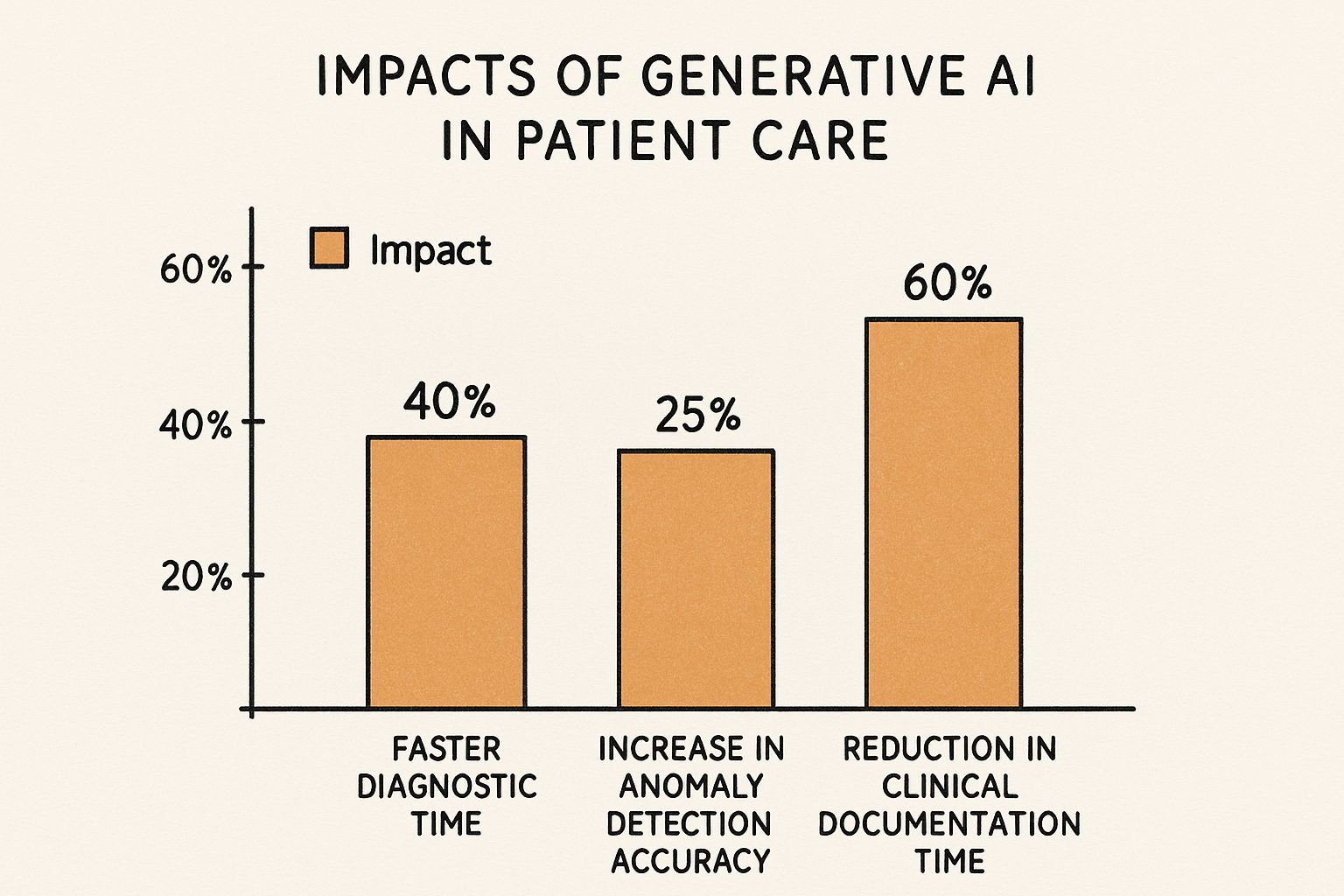
What jumps out immediately is the 60% reduction in the time doctors spend on clinical documentation. That's a direct hit against one of the biggest drivers of physician burnout.
To better understand how these changes are playing out, let's look at a few key applications that are making a real difference. The following table breaks down some of the most impactful use cases.
Top Generative AI Applications in Healthcare
| Application Area | Challenge Addressed | Key Benefit |
|---|---|---|
| Medical Imaging Analysis | High volume of scans, risk of human error from fatigue, and subtle anomaly detection. | Faster, more accurate diagnoses; reduced radiologist workload; early detection of critical conditions. |
| Personalized Medicine | "One-size-fits-all" treatment approaches that don't account for individual genetic or lifestyle factors. | Highly tailored treatment plans that improve efficacy and minimize side effects for individual patients. |
| Clinical Documentation | Excessive time spent on manual data entry into EHRs, leading to physician burnout and less patient interaction. | Dramatically reduced administrative burden, more face-to-face patient time, and improved note accuracy. |
| Drug Discovery & Development | The incredibly long and expensive process of identifying viable drug candidates and predicting their effects. | Accelerated research cycles, identification of novel drug targets, and more efficient clinical trial design. |
These examples are just the beginning, but they highlight how generative AI is addressing some of the most persistent and costly problems in the healthcare system.
Revolutionizing Diagnostics and Anomaly Detection
One of the most powerful and immediate applications of generative AI is in medical imaging. Radiologists and pathologists are now working with AI models that can analyze X-rays, CT scans, and MRIs with incredible speed and a sharp eye for detail.
Think of it as a tireless expert assistant. These AI systems are trained on millions of images, allowing them to spot subtle patterns or anomalies that a human might miss, especially after a long shift. The AI doesn't make the final call; instead, it highlights potential areas of concern, directing the human specialist’s attention right where it's needed most.
This human-AI collaboration is leading to some fantastic outcomes:
- Faster diagnoses, which is absolutely critical for conditions like cancer or stroke where every minute counts.
- Increased accuracy, cutting down on the risk of false negatives and making patient care safer.
- Smarter workflows, helping radiologists manage overwhelming caseloads far more effectively.
Crafting Personalized Treatment Plans at Scale
Every patient is different. Their genetic makeup, lifestyle, and medical history all play a role in their health. Generative AI is finally making it possible to move beyond generic treatment protocols and deliver truly personalized medicine.
By analyzing a huge dataset for a single patient—genomic data, lab results, clinical notes, and more—the AI can build a comprehensive profile of their specific condition. From there, it can generate potential treatment plans tailored to that unique profile, suggesting therapies with the highest probability of success and the lowest risk of side effects. For instance, our own https://www.ekipa.ai/products/clinic-ai-assistant is built on this principle of using AI to streamline patient data for better, more informed clinical decisions.
This is like giving every single patient their own dedicated research team, one that can synthesize all available medical knowledge to map out the best path forward.
For a broader look at how this technology is being applied across different industries, you can explore Illumichat's Use Cases.
Automating the Burden of Clinical Documentation
Clinician burnout is a full-blown crisis, and a massive part of the problem is the mountain of administrative work. Doctors and nurses often spend more time staring at a screen and typing into Electronic Health Records (EHRs) than they do actually talking to their patients. Generative AI is tackling this problem head-on.
One of the biggest game-changers is ambient listening technology. These tools run quietly in the background during a patient visit, capturing the natural conversation and automatically generating a structured, accurate clinical note.
The benefits are immediate and profound:
- More Face-to-Face Time: Doctors can finally maintain eye contact and build a real connection with patients instead of being glued to a keyboard.
- Reduced Administrative Load: This technology eliminates hours of after-hours charting, giving clinicians their personal time back.
- Improved Note Quality: AI-generated summaries are often more comprehensive and consistent than notes typed up from memory late at night.
Improving Operations and Accelerating Medical Research
Generative AI's influence isn't just confined to the exam room; it's making waves all the way from the research lab to the back office. While better patient care is the ultimate goal, the technology also has an incredible knack for smoothing out hospital operations and putting medical discovery on the fast track. It's a two-pronged approach that helps organizations improve both patient outcomes and their own financial health.
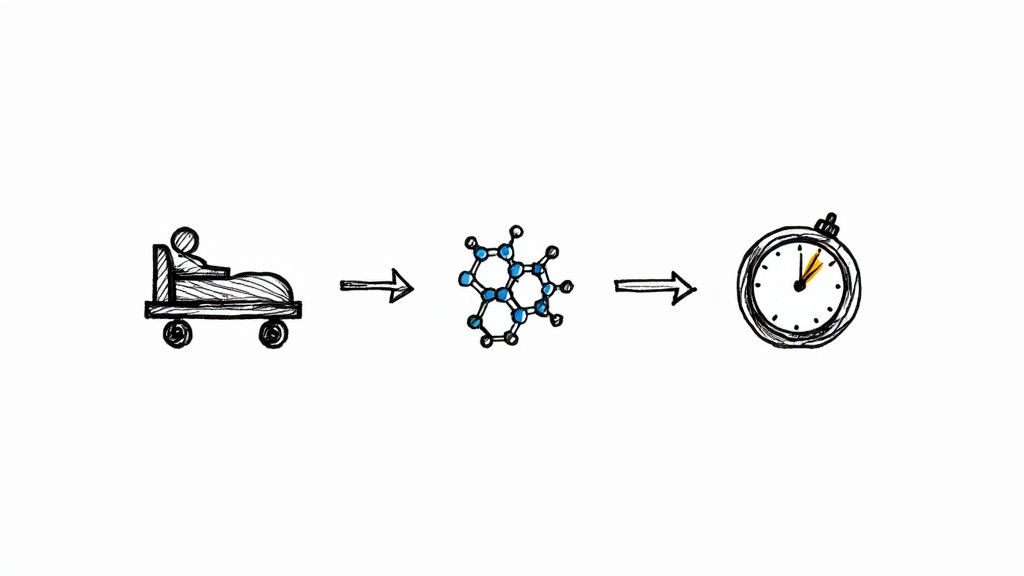
On one hand, generative AI tackles the crushing operational complexity that can slow a modern hospital to a crawl. On the other, it hands researchers the tools to unlock biological secrets faster than we ever thought possible.
Fueling the Next Wave of Drug Discovery
Bringing a new medicine to market is a marathon. The journey from a promising hypothesis to an approved drug is famously long and incredibly expensive, often taking more than a decade and costing billions. Generative AI is starting to change that entire equation.
Instead of just trial and error, these AI models can dive into massive biological datasets to predict how certain molecules might behave inside the human body. This allows scientists to zero in on the most promising drug candidates with far greater speed and accuracy.
Here’s a glimpse of how it’s unfolding:
- Target Identification: AI can comb through genomic and proteomic data to spot new biological targets—the root causes—linked to specific diseases.
- Molecule Generation: Instead of just screening existing compounds, generative models can design completely novel molecular structures from the ground up, tailored to interact perfectly with those targets.
- Predictive Analysis: The system can then forecast a potential drug's effectiveness, toxicity, and likely side effects long before it's ever synthesized in a lab, saving an enormous amount of time and money.
Think of it like a powerful digital laboratory. Generative AI can simulate thousands of biological experiments in a fraction of the time it would take to conduct them in the real world, dramatically speeding up the entire preclinical phase.
Bringing generative AI into the lab is a huge step forward, building on and amplifying other modern approaches to research organization that are also pushing for greater efficiency and new discoveries.
Optimizing the Engine of Hospital Operations
While researchers are busy making breakthroughs, hospital administrators are fighting a different battle: operational gridlock. The administrative burden is immense, with some clinicians reporting they lose nearly 28 hours a week to paperwork and other non-clinical tasks. Generative AI offers a powerful fix through intelligent automation.
This isn't about replacing people. It's about giving them powerful assistants so they can get back to the work that truly matters.
Look at some of the key operational fixes:
- Intelligent Scheduling: AI can analyze historical patterns, patient needs, and resource availability to optimize everything from appointments and surgical schedules to staff rotas. The result is shorter wait times and fewer bottlenecks.
- Automated Medical Billing and Coding: Generative AI can read a doctor's clinical notes and instantly generate the correct medical codes for billing. This cuts down on the human errors that lead to denied claims and lost revenue.
- Bed and Resource Management: Predictive models can forecast patient admission and discharge rates, helping hospitals manage bed capacity and ensure that critical resources, like operating rooms, are always used effectively.
By automating these complex yet repetitive processes, generative AI frees up skilled professionals and simply helps the entire healthcare system run more smoothly.
A Practical Guide to Bringing Generative AI into Your Healthcare Practice
Bringing generative AI into a healthcare setting isn't just about plugging in new software. It's about a fundamental shift that requires a clear, well-thought-out vision. For any leader in this space, the first step is creating a realistic roadmap that accounts for the technology, the people who will use it, and the processes it will change. A smooth rollout depends entirely on careful planning, from locking down data security to navigating the human side of organizational change.
The journey starts with strategy, not with tech. Before you even look at a single tool, you need to have an honest conversation about the specific, high-value problems you're trying to solve. Kicking things off with a Custom AI Strategy report helps zero in on pilot projects that promise the biggest return, making sure your time and money are spent where they’ll make a real difference. This foundational work is at the heart of our implementation support.
Building a Strong Foundation for Success
Before you can even think about implementation, you need to get a few critical things right. Think of these as the non-negotiable pillars for any generative AI healthcare project.
- Data Security and HIPAA Compliance: This is table stakes. Patient data is incredibly sensitive, and any AI system you bring in has to be built with ironclad security protocols that meet—and preferably exceed—HIPAA standards. We're talking about robust data encryption, strict access controls, and regular security audits to keep everything protected.
- Ethical Guardrails: An AI model is a reflection of the data it learns from. It's absolutely crucial to establish a governance framework to watch for and correct algorithmic bias. The last thing you want is a tool that accidentally widens existing health disparities instead of closing them.
- The Build vs. Buy Decision: This is a classic crossroads. Do you build a custom solution from the ground up or buy something off the shelf? Building gives you total control but demands serious resources and deep expertise in healthcare software development. Buying gets you up and running faster, but you might have to compromise on custom features.
Nailing down these strategic points from the start makes the entire adoption process a whole lot smoother.
Getting Your Team On Board
Technology is just a tool; it's the people who make it work. Often, the biggest hurdle to adopting AI isn't technical—it's cultural. That’s why a solid change management plan and thorough staff training are so important for getting your clinical teams to embrace the new systems.
The key is to show them that AI is here to help, not to replace them. Training needs to be practical, focusing on real-world workflow automation. When doctors and nurses see for themselves how these tools can cut down their paperwork and free them up to spend more time with patients, you start to win them over.
At the end of the day, successful implementation is less about deploying software and more about building confidence. When your clinical staff views AI as a helpful partner that makes their jobs easier, genuine adoption will follow.
This people-first mindset is what truly unlocks AI's potential.
Proving the Value and Measuring the Impact
To make the case for investing in generative AI, you have to define what success looks like. Measuring return on investment (ROI) isn't just about the bottom line; it's about tracking tangible improvements in efficiency, patient outcomes, and even staff morale.
A few key performance indicators (KPIs) you should be tracking include:
- Less Time on Admin: Measure the real drop in hours clinicians spend on charting and other documentation.
- Smarter Diagnostics: Keep an eye on any changes in diagnostic error rates or how long it takes to get a diagnosis from medical images.
- Better Patient Flow: Monitor how scheduling efficiency and bed turnover rates improve over time.
The expectations for these kinds of gains are incredibly high. Across the globe, over 80% of healthcare executives believe generative AI will have a significant (26%) or moderate (55%) impact on their organizations by 2025. This isn't just hype; it reflects a widespread understanding that AI can deliver real improvements in productivity and patient care. As the technology becomes more common, regulatory bodies like the FDA are also stepping up to create new guidelines for AI safety and management. You can discover more insights about these executive outlooks and regulatory shifts here.
A clear strategy, paired with a disciplined development process, ensures that every step you take is aimed at achieving these concrete, measurable results.
The Future of Medicine and Generative AI
If we look down the road, it's not hard to see generative AI in healthcare becoming as essential as the stethoscope. The technology is quickly evolving past simple administrative tasks and starting to embed itself into the core of clinical work. We're standing at the edge of a new era defined by truly personalized and predictive medicine—a future where healthcare is proactive, not just reactive.
Think about an AI that doesn't just look at your current health status but actually predicts future disease risks. It could analyze your specific genetic code, lifestyle choices, and even environmental exposures to suggest preventative measures long before you ever feel sick. This shift turns medicine on its head, focusing on keeping people well instead of just treating them when they're ill. This kind of forward-thinking is a central piece of any mature AI strategy consulting effort.
The Dawn of Predictive and Personalized Care
One of the most fascinating developments on the horizon is the creation of AI-powered "digital twins." These are incredibly detailed virtual replicas of a patient's body, built by combining all of their available clinical data.
Imagine a doctor using this digital model to simulate how a new drug might work for a specific person, all without any real-world risk. It's a move away from one-size-fits-all treatments toward hyper-personalized care plans.
Another major trend gaining steam is ambient clinical intelligence. Picture a doctor's exam room where the technology just works, completely in the background. As a doctor and patient have a normal conversation, microphones and sensors capture everything, and an AI system documents the visit in real-time. This simple change gets rid of tedious note-taking and lets doctors focus completely on their patients.
The ultimate goal is to create an intelligent, collaborative healthcare ecosystem. The trajectory is clear—medicine is becoming more predictive, deeply personalized, and powered by smart automation.
Navigating the Road Ahead
Of course, this future won't just appear overnight. There are still major hurdles to clear, from navigating complex regulations to answering tough ethical questions. And most importantly, building trust with both patients and the clinicians who will use these tools is absolutely crucial for them to be accepted. As we explored in our AI adoption guide, a thoughtful approach to implementation makes all the difference.
The journey to bring these powerful AI solutions into everyday practice is just getting started. This exciting new chapter requires a partner with deep technical knowledge and a strategic mindset. The work begins now, and our expert team is ready to help guide your organization at every stage.
Frequently Asked Questions
As we explore generative AI in healthcare, a few key questions always seem to come up. Let's tackle some of the most common ones.
What’s the Toughest Part of Bringing AI into a Healthcare Setting?
The biggest hurdles usually fall into three buckets: data security, system integration, and regulatory compliance. Patient data is incredibly sensitive and heavily protected by laws like HIPAA, so any AI solution has to be ironclad from a security standpoint. That's non-negotiable.
On top of that, you have the technical challenge of making new AI tools talk to older, often clunky, Electronic Health Record (EHR) systems. Finally, you can't just drop new tech on clinical staff and expect them to use it. Gaining their trust through good training and proving the tool actually helps them is critical for it to stick.
How Can We Make Sure AI Is Used Ethically with Patients?
Ensuring ethical AI use really comes down to having a solid governance framework in place. This means creating clear rules around data privacy and constantly checking algorithms for biases that might create or worsen health inequities. It's also about keeping a human clinician involved in all final, critical decisions.
Transparency is also a huge piece of the puzzle. Doctors—and even patients—should have a basic understanding of how an AI model arrives at its conclusions. A great way to manage this is by forming an ethics committee with diverse experts to oversee how AI is rolled out, building trust and making sure the tech truly serves every patient's needs. If you want to dive deeper into this process, our guide on the AI Product Development Workflow is a great resource.
Is Generative AI Only for Big Hospital Chains?
Absolutely not. While massive hospital systems might have the resources to build custom AI from scratch, smaller clinics and private practices can get huge benefits from more accessible cloud-based tools. Think of things like AI-powered medical scribes or automated patient scheduling—many of these are available as affordable, scalable subscription services.
These AI tools for business are designed to help smaller practices cut down on administrative busywork, run more efficiently, and give their clinicians more time to focus on what they do best: care for patients. It's all about finding the right tool to solve your most pressing problem.
Ready to see what generative AI could do for your healthcare organization? It all starts with a smart plan. At Ekipa AI, we help businesses pinpoint the best AI opportunities and map out a clear path forward. Get your Custom AI Strategy report in 24 hours and start building the future.

